部编初一年级英语下册电子教案七下Unit7一课时
- 格式:doc
- 大小:5.86 MB
- 文档页数:8
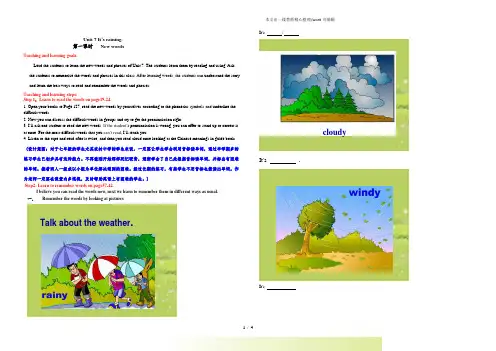
Unit 7 It ’s raining. 第一课时 New wordsTeaching and learning goals:Lead the students to learn the new words and phrases of Unit 7. The students learn them by reading and using. Ask the students to memorize the words and phrases in this class. After learning words, the students can understand the story and learn the best ways to read and remember the words and phrases.Teaching and learning steps:Step 1:Learn to read the words on page19-24.1. Open your books to Page 127, read the new words by yourselves according to the phonetics symbols and underline the difficult words.2. Now you can discuss the difficult words in groups and try to get the pronunciation right.3. I ’ll ask one student to read the new words. If the student’s pronunciation is wrong, you can offer to stand up to correct it at once. For the most difficult words that you can’t read, I ’ll teach you.4. Listen to the tape and read after it twice, and then you read aloud once looking at the Chinese meanings in guide book . (设计意图:对于七年级的学生尤其农村中学的学生来说,一定要让学生学会利用音标读单词,通过半学期多的练习学生已初步具有这种能力。

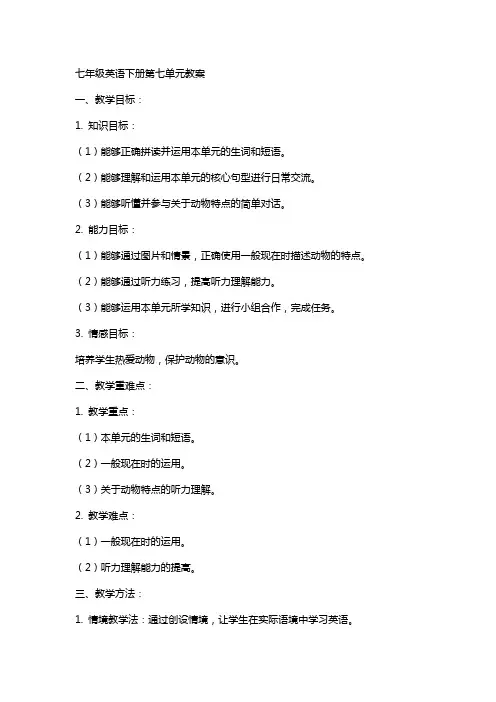
七年级英语下册第七单元教案一、教学目标:1. 知识目标:(1)能够正确拼读并运用本单元的生词和短语。
(2)能够理解和运用本单元的核心句型进行日常交流。
(3)能够听懂并参与关于动物特点的简单对话。
2. 能力目标:(1)能够通过图片和情景,正确使用一般现在时描述动物的特点。
(2)能够通过听力练习,提高听力理解能力。
(3)能够运用本单元所学知识,进行小组合作,完成任务。
3. 情感目标:培养学生热爱动物,保护动物的意识。
二、教学重难点:1. 教学重点:(1)本单元的生词和短语。
(2)一般现在时的运用。
(3)关于动物特点的听力理解。
2. 教学难点:(1)一般现在时的运用。
(2)听力理解能力的提高。
三、教学方法:1. 情境教学法:通过创设情境,让学生在实际语境中学习英语。
2. 任务型教学法:通过完成任务,提高学生的综合语言运用能力。
3. 交际法:通过师生互动,生生互动,提高学生的口语表达能力。
四、教学过程:1. 热身(5分钟)(1)和学生进行简单的对话,询问他们喜欢的动物。
(2)引导学生谈论动物的特点。
2. 引入(10分钟)(1)展示本节课的主题:动物的特点。
(2)引导学生谈论不同动物的特点。
3. 课堂讲解与实践(20分钟)(1)讲解一般现在时的用法。
(2)引导学生用一般现在时描述动物的特点。
(3)进行小组活动,让学生互相描述动物的特点。
4. 听力练习(15分钟)(1)播放听力材料,让学生听懂并理解。
(2)引导学生回答与听力材料相关的问题。
(2)布置作业:用一般现在时描述自己喜欢的动物。
五、教学反思:通过本节课的教学,发现学生在使用一般现在时描述动物特点方面存在一定的困难,需要在今后的教学中加强练习。
学生在听力理解方面也有待提高,需要增加更多的听力材料,提高他们的听力能力。
六、教学评价:1. 课堂参与度:观察学生在课堂上的积极参与情况,以及他们的口语表达和小组合作能力。
2. 作业完成情况:检查学生作业的完成质量,看是否能够正确使用一般现在时描述动物的特点。
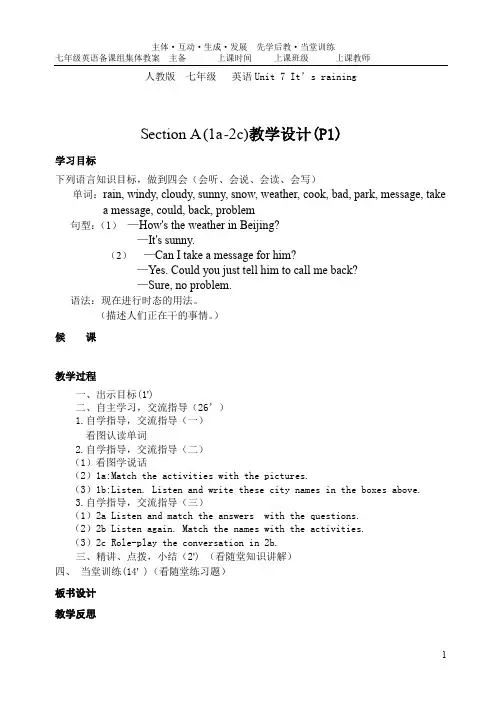
人教版七年级英语Unit 7 It’s rainingSection A (1a-2c)教学设计(P1)学习目标下列语言知识目标,做到四会(会听、会说、会读、会写)单词:rain, windy, cloudy, sunny, snow, weather, cook, bad, park, message, takea message, could, back, problem句型:(1)—How's the weather in Beijing?—It's sunny.(2)—Can I take a message for him?—Yes. Could you just tell him to call me back?—Sure, no problem.语法:现在进行时态的用法。
(描述人们正在干的事情。
)候课教学过程一、出示目标(1')二、自主学习,交流指导(26’)1.自学指导,交流指导(一)看图认读单词2.自学指导,交流指导(二)(1)看图学说话(2)1a:Match the activities with the pictures.(3)1b:Listen. Listen and write these city names in the boxes above.3.自学指导,交流指导(三)(1)2a Listen and match the answers with the questions.(2)2b Listen again. Match the names with the activities.(3)2c Role-play the conversation in 2b.三、精讲、点拨,小结(2')(看随堂知识讲解)四、当堂训练(14' )(看随堂练习题)板书设计教学反思人教版七年级英语Unit 7 It’s rainingSection A 2d-3b 教学设计(P2)学习目标下列语言知识目标,做到四会(会听、会说、会读、会写)1.继续练习运用描述天气情况、描述正在发生的动作。
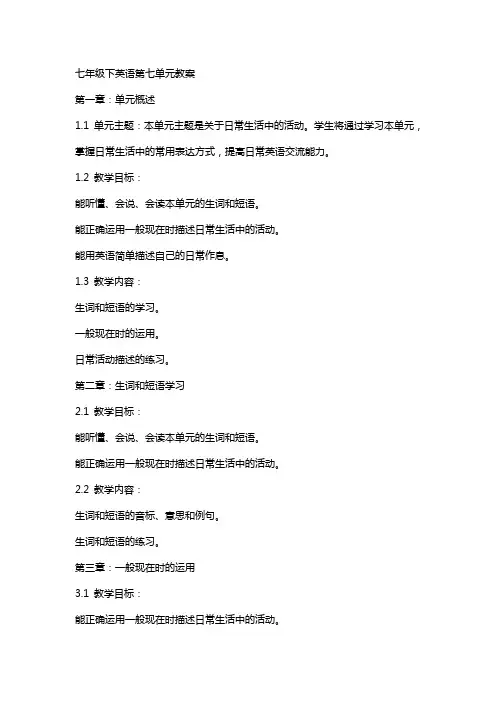
七年级下英语第七单元教案第一章:单元概述1.1 单元主题:本单元主题是关于日常生活中的活动。
学生将通过学习本单元,掌握日常生活中的常用表达方式,提高日常英语交流能力。
1.2 教学目标:能听懂、会说、会读本单元的生词和短语。
能正确运用一般现在时描述日常生活中的活动。
能用英语简单描述自己的日常作息。
1.3 教学内容:生词和短语的学习。
一般现在时的运用。
日常活动描述的练习。
第二章:生词和短语学习2.1 教学目标:能听懂、会说、会读本单元的生词和短语。
能正确运用一般现在时描述日常生活中的活动。
2.2 教学内容:生词和短语的音标、意思和例句。
生词和短语的练习。
第三章:一般现在时的运用3.1 教学目标:能正确运用一般现在时描述日常生活中的活动。
能用英语简单描述自己的日常作息。
3.2 教学内容:一般现在时的结构:主语+ 动词原形。
一般现在时的用法:描述习惯性动作、经常发生的事情。
一般现在时的练习。
第四章:日常活动描述的练习4.1 教学目标:能用英语简单描述自己的日常作息。
能正确运用一般现在时描述日常生活中的活动。
4.2 教学内容:日常活动描述的模板:I usually do sth in the morning/afternoon/evening. 日常活动描述的练习。
第五章:课堂活动与练习5.1 教学目标:能听懂、会说、会读本单元的生词和短语。
能正确运用一般现在时描述日常生活中的活动。
能用英语简单描述自己的日常作息。
5.2 教学内容:小组活动:用本单元的生词和短语进行对话,描述自己的日常活动。
个人练习:写一篇关于自己日常活动的短文。
第六章:听力练习6.1 教学目标:能听懂日常生活中的活动相关的对话。
能根据听到的内容回答问题。
6.2 教学内容:听力材料:日常生活中的活动对话。
听力练习:根据听到的对话,选择正确的答案。
第七章:口语表达7.1 教学目标:能用英语描述日常生活中的活动。
能在小组活动中进行日常活动的交流。



Unit 7 It’s raining!第一课时Section A (1a—2d )学习目标:1、重点单词rain (v.&n.)下雨;雨水windy (adj.)多风的cloudy (adj.)多云的sunny(adj.)晴朗的snow (v.& n.)下雪cook (v.)做饭bad(adj.)坏的park(n.)公园message(n.)信息;消息him(pron.)他could(modal v.)可以problem(n.)难题2、重点词组take a massage捎信call sb. back给某人回电话have a good time玩得开心no problem没问题3、重点句式1. How is the weather in Beijing?北京天气怎么样?---It’s sunny. 天气晴朗。
2. ---How is it going ? 一切都好吗?---Not bad. 还不错。
3. What are they doing? 他们在做什么?4. They are playing basketball. 他们在打篮球。
5. He is studying in his friend’s home. 他正在朋友家学习。
重点难点:1. 现在进行时的用法和判定;2. 天气的提问和回答。
导学设计:1. How's the weather in Shanghai?上海的天气怎么样?【归纳】(1)How is the weather?意为“天气怎么样?”,是用来询问天气状况的常用句型,还可以用“What's the weather like?”。
询问某地的天气时,在句子末尾加介词短语“in+某地”。
如:How's the weather in Beijing?(=What's the weather like in Beijing?) 北京的天气怎么样?(2)weather为不可数名词,意为“”,前面不能用不定冠词a/an。
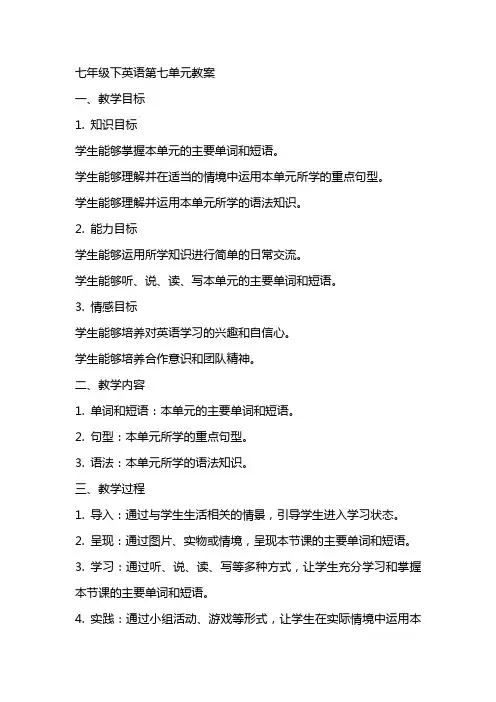
七年级下英语第七单元教案一、教学目标1. 知识目标学生能够掌握本单元的主要单词和短语。
学生能够理解并在适当的情境中运用本单元所学的重点句型。
学生能够理解并运用本单元所学的语法知识。
2. 能力目标学生能够运用所学知识进行简单的日常交流。
学生能够听、说、读、写本单元的主要单词和短语。
3. 情感目标学生能够培养对英语学习的兴趣和自信心。
学生能够培养合作意识和团队精神。
二、教学内容1. 单词和短语:本单元的主要单词和短语。
2. 句型:本单元所学的重点句型。
3. 语法:本单元所学的语法知识。
三、教学过程1. 导入:通过与学生生活相关的情景,引导学生进入学习状态。
2. 呈现:通过图片、实物或情境,呈现本节课的主要单词和短语。
3. 学习:通过听、说、读、写等多种方式,让学生充分学习和掌握本节课的主要单词和短语。
4. 实践:通过小组活动、游戏等形式,让学生在实际情境中运用本节课所学的句型和语法知识。
5. 巩固:通过课后作业、小测验等形式,巩固本节课所学知识。
四、教学评价1. 课堂参与度:观察学生在课堂上的参与情况,是否积极回答问题、参与小组活动等。
2. 作业完成情况:检查学生作业的完成质量,是否能够正确运用本节课所学知识。
3. 小测验成绩:通过小测验,了解学生对所学知识的掌握程度。
五、教学资源1. 教学课件:通过课件,展示本节课的主要知识点。
2. 单词卡片:用于学生学习和巩固单词。
3. 实物或图片:用于呈现本节课的主要单词和短语。
4. 小组活动材料:用于学生进行小组活动和实践。
5. 课后作业:用于学生巩固本节课所学知识。
六、教学策略1. 任务型教学法:通过设计各种任务,让学生在完成任务的过程中运用所学知识,提高学生的综合语言运用能力。
2. 情境教学法:通过创设真实、生动的情境,让学生在实际情境中学习、运用英语。
3. 合作学习:组织学生进行小组合作,培养学生的团队协作能力和沟通能力。
4. 激励性评价:注重鼓励和表扬学生,激发学生的学习兴趣和自信心。
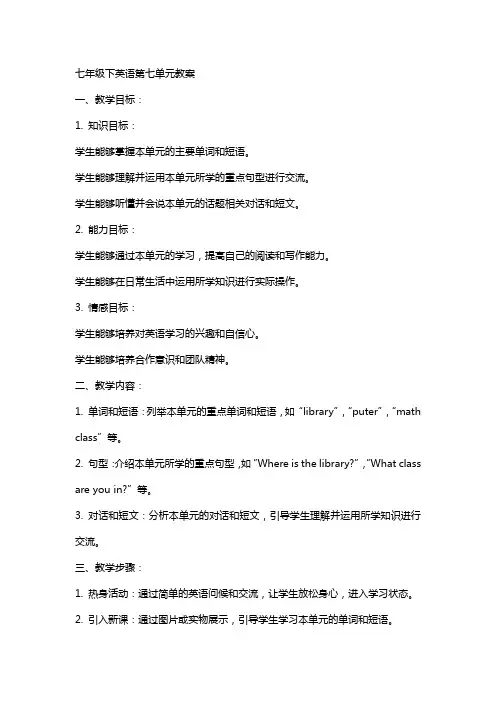
七年级下英语第七单元教案一、教学目标:1. 知识目标:学生能够掌握本单元的主要单词和短语。
学生能够理解并运用本单元所学的重点句型进行交流。
学生能够听懂并会说本单元的话题相关对话和短文。
2. 能力目标:学生能够通过本单元的学习,提高自己的阅读和写作能力。
学生能够在日常生活中运用所学知识进行实际操作。
3. 情感目标:学生能够培养对英语学习的兴趣和自信心。
学生能够培养合作意识和团队精神。
二、教学内容:1. 单词和短语:列举本单元的重点单词和短语,如“library”,“puter”,“math class”等。
2. 句型:介绍本单元所学的重点句型,如“Where is the library?”,“What class are you in?”等。
3. 对话和短文:分析本单元的对话和短文,引导学生理解并运用所学知识进行交流。
三、教学步骤:1. 热身活动:通过简单的英语问候和交流,让学生放松身心,进入学习状态。
2. 引入新课:通过图片或实物展示,引导学生学习本单元的单词和短语。
3. 讲解句型:通过例句和练习,讲解本单元的重点句型。
4. 对话和短文:让学生听懂并模仿对话和短文,引导学生进行实际交流。
5. 巩固练习:通过小组活动和游戏,巩固所学知识。
6. 总结和新课预告:对本单元所学内容进行总结,并预告下一单元的教学内容。
四、教学评价:1. 课堂参与度:观察学生在课堂上的参与情况和积极性。
2. 口语表达:评估学生在实际交流中的口语表达能力。
3. 作业和测试:通过作业和测试,评估学生的学习效果。
五、教学资源:1. 教材:使用七年级下英语教材。
2. 课件:制作精美的课件,辅助教学。
3. 实物和图片:准备相关的实物和图片,帮助学生更好地理解和记忆。
4. 音频和视频:利用音频和视频材料,提高学生的听力和口语能力。
六、教学策略:1. 任务型教学法:通过设计各种实际任务,让学生在完成任务的过程中学习和运用英语。
2. 交际型教学法:鼓励学生进行互动交流,提高他们的口语表达能力和听力理解能力。

Unit 7 It’s raining. Section A 1a-2c一、课题It’s raining.二、课型Listening and speaking三、教材分析本单元位于第六单元之后,语法点讲解以进行时为主,并且区分一般现在时和现在进行时的区别。
在功能对话方面,通过打电话的方式,把天气作为small talk的话题,并且对正在进行的活动进行描述。
本课时为unit 7的第一课时,通过进行时引入描述天气的形容词,并且引入谈论天气的问句及相应的答句。
运用所学句型谈论不同地点的天气情况,融合已学的进行时对正在进行的活动进行问答,通过打电话创设情景,引导学生在情境中学习。
四、学情分析学生在unit 6 已经学习了现在进行时的用法,对于本单元的天气的表达,可借助现在进行时来引入其他天气描述词,如It’s raining/ snowing. It’s rainy/ snowy.引入新词rainy, snowy的学习,以及其他描述天气的形容词。
并且本节课中通过电话交谈,结合天气和日常活动,进行日常交流,引导学生了解西方small talk 的文化。
五、教学目标1.知识目标:能掌握生词weather,rainy, snowy, cloudy, snowy, cook 的词义和用法。
2.能力目标:能运用句型“-How’s the weather in ...? -It’s ... ”对不同地点就天气问题进行提问。
3.策略目标:能借助课件中的动态图、视频和生活经验,学习新词汇。
4.情感态度:能积极参与到课堂活动中去,认真倾听他人发言,积极参与小组活动。
5.文化意识:能了解到西方文化中的天气常作为small talk(闲聊)的话题。
六、教学重难点1.教学重点询问不同地点的天气的句型结构及回答方式。
-How’s the weather in Beijing?-It’s + raining / rainy .通过观看视频,引出重点,并且在听前进行单词教读,反复进行师生对话、生生对话来突出该句型结构。
七年级下英语第七单元教案新部编本教师学科教案[ 20 – 20 学年度第__学期]任教学科:_____________任教年级:_____________任教⽼师:_____________xx市实验学校Unit 7 The Birthday PartyTopic 1 When is your birthday?主备⼈:⽯勇Section A(1a, 1b, 1c, 3a,3b-A)Period: 1 period.I. Teaching Aims :1. Knowledge and Skills:(1)Learn the names of months:January, February, March, April, May, June, July, August, September, October, November, December(2) Learn to read the years in English.(3) Learn some other new words and phrases:was, be born, were, thousand, sport(4)Learn the past simple tense with “was/were”.When was he born, do you know? He was born in June, 1985.Where was he born? In Maryland, the U.S.A.When were you born? I was born in …(5)Improve Ss’ listening and speaking skills.2. Process and Methods:(1) Question-and-answer activities.(2)Let Ss work alone, in pairs, groups to make them learn more easily and better.(3)Give Ss tasks to make them learn better.3. Emotion and Values:(1)Encourage Ss to work in pairs to improve their cooperation abilities.(2)Let Ss learn to care about their parents and those people who love them.II.Teaching Keys:1. Learn the names of months.2. Learn the past simple tense with “was/were”.3. Improve Ss’ listening and speaking skills.III.Teaching Difficulties:1. Learn the names of months.2. Use t he past simple tense with “was/were”.IV.Teaching aids:A courseware, a calendar, and some objects.V. Teaching process:Step 1 Lead in1. S how the Yao Ming’s picture to lead in the title of Unit 7 the Birthday Party Topic 1 When is your birthday? Section A.2. Show Ss a calendar to lead in the twelve months in English.Step 2 Presentation1. Present the names of the twelve months and learn one by one.2. Play the movie of 1b and let Ss read after it.3. Play a guessing game to practice the names of the months, then finish 3b-A.4. Present some years and learn to read them.5. Show Ss some years with months and help Ss to read them, finish Task 1.Task1:Read and write the years in English.1800 _________________________________________1820 _________________________________________1903 _________________________________________1996 _________________________________________2009 _________________________________________2050 _________________________________________6. Play the “presents” game to help Ss read the years with months fluently.7.Show Ss a picture of Liu Xiang to present the conversation like this:L: I was born in July, 1983, and I was born in Shanghai.T: When were you born? Where were you born?Ask each student to write his/her own birth of month, birth of year and birth place like this “I was born in June, 1997. I was born in ....”Finish Task 2.Task2:Write down your month of birth, year of birth and birthplace.(写出你⾃⼰的出⽣年、⽉和出⽣地。
Unit 7It's raining!类别课程标准要求掌握的项目话题The weather重点单词Section A1.rain v.下雨n.雨水2.windy adj.多风的3.cloudy adj.多云的4.sunny adj.晴朗的5.snow v.下雪n.雪6.weather n.天气7.cook v.做饭8.bad adj.坏的;糟的9.park n.公园10.message n.信息;消息11.back ad v.回来;回原处12.problem n.困难;难题13.again ad v.再一次;又一次Section B14.dry adj.干燥的15.cold adj.寒冷的;冷的16.hot adj.热的17.warm adj.温暖的18.visit v.拜访;参观19.Canada n.加拿大20.summer n.夏天;夏季21.sit v.坐22.juice n.果汁;饮料23.soon ad v.不久;很快24.vacation n.假期25.hard ad v.努力地adj.困难的26.Europe n.欧洲27.mountain n.高山28.country n.国;国家29.skate v.滑冰30.snowy adj.下雪的31.winter n.冬天;冬季32.Russian adj. 俄罗斯的n.俄罗斯人;俄语33.snowman n.雪人34.rainy adj.阴雨的;多雨的重点短语Section A1.have a good time过得愉快2.take a message捎个口信;传话3.sound like听起来像4.call (sb.) back(给某人)回电话5.right now此刻;马上Section B6.have fun玩得开心7.on (a) vacation度假重点句型1.—How s the weather?天气怎么样?—It s raining./It s sunny.在下雨。
2019-2020 学年人教版英语七年级下册教课方案表第一课时学年七教课Unit 7 It ’s raining. 日校级年师题期级备课项目序分值首备地区复备地区号1 4 分Language Goal: Describe the weather. And whatyou are doing.备课标与Teaching Aims:The present Progressive (构造教材式: Be + V-ing ) 以及能用 how 指引的问句表达问(10 分)候。
Talk about what people are doing.Improve students’ ability of communicativecompetence.2 3 分教课要点:学习运用要点句型和语法点: - --How is the weather? It’raining.--What’ s he doing ?---He’s playing soccer.教课难点:此刻进行时的用法和动词 V-ing 形式的组成。
3 3 分课标要求:学会商论天气,以及人们正在做什么,进一步培育综合语言运用能力。
1 5 分学生在前面的单元已经学习了此刻进行时态并熟备学情练运用了一些简单的活动的短语。
对于天气的表达( 15 分)也接触过。
SectionA 描绘天气的五个形容词, 2a,2b 经过听力训练进一步学习此刻进行时,并稳固相关打电话的平时用语;电话用语也是要点之一联合当日天气状况或利用多媒体播放天气预报,引入相关天气的词汇和句型。
第7单元是前面现在进行时态的延伸,话题231备教课目 2 标(15分)34 备教课方 1 法与媒体(15分)212 教课流程(35分)345密切相连并进一步深入。
5 分部分学困生在学习英语的过程中说有问题,不可以参加小组活动。
他们既感觉好奇又担忧,希望能获得别人的一定。
5 分教师经过幻灯片显现教课内容,小组交流、显现、PK 、评论使学生进行流畅、正确或基本三个层次的练习。
Unit 7 It’s raining.第一课时New wordsTeaching and learning goals:Lead the students to learn the new words and phrases of Unit 7. The students learn them by reading andusing. Ask the students to memorize the words and phrases in this class. After learning words, the students canunderstand the story and learn the best ways to read and remember the words and phrases.Teaching and learning steps:Step 1:Learn to read the words on page19-24.1. Open your books to Page 127, read the new words by yourselves according to the phonetics symbols and underline the difficult words.2. Now you can discuss the difficult words in groups and try to get the pronunciation right.3. I’ll ask one student to read the new words. If the student’s pronunciation is wrong, you can offer to stand up to correct it at once. For the most difficult words that you can’t read, I’ll teach you.4. Listen to the tape and read after it twice, and then you read aloud once looking at the Chinese meanings in guide book .(设计意图:对于七年级的学生尤其农村中学的学生来说,一定要让学生学会利用音标读单词,通过半学期多的练习学生已初步具有这种能力。
不再像刚开始那样死记硬背,逐渐学会了自己先根据音标读单词,并标出有困难的单词。
接着两人一组或以小组为单位解决遇到的困难。
经过长期的练习,有些学生不用音标也能读出单词。
作为老师一定要在课堂内多巡视,及时帮助英语上有困难的学生。
)Step2:Learn to remember words on page37-42.I believe you can read the words now, next we learn to remember them in different ways as usual. 一.Remember the words by looking at pictures.Talk about the weather.It’s / .cloudyIt’s .It’s .It’s / .It ’s .ShanghaiBostonBeijingMoscowWeather ForecastGood morning, ladies and gentlemen! Here is the weather forecast! Today is Wednesday .Beijing is . Boston is .Moscow is .And it is cold.Shanghai is .skate wintersnowysnowman Russian rainy(1) Do you like ?(滑冰)(2) It’s in . Let’s make a .(冬天下雪,让我们堆雪人吧。
)(3) They are .(俄罗斯人)(设计意图:在具体的语境中,利用图片教授新词,直观形象,既记住了单词,又学会了单词的用法,使其轻松地把英语和汉语对应起来,达到了轻松愉快学习的目的。
)二. Remember the words by matching itself with their similar meaning.cook not goodbad make dinnerproblem in a minutesoon questionhard take a holidayon a vacation difficultagain phone sb backcall sb back once morecould pass a message to sbtake a message be able tocountry nation(设计意图:通过英语释义让学生猜测新词组的含义,然后让学生根据其意思连线,以此给学生提供根据英语释义记忆单词的语境,培养学生在语境中学习新词的能力,以旧带新,符合学生语言的认知规律。
)三. Remember the words by their similar pronunciations and forms.1. n e ver--e very--m e ssage [e]2. sw ea ter--w ea ther [e]3. pr a ctice--h a ve--b a ck [æ]4. p ar k—h ar d—sm ar t—m ar ket—f ar [a:]四. Remember the words by conversion(转换) 、complex words (合成)and derivative(派生)1. America n. 美国--American n/adj美国人,美国人的Australia n.澳大利亚--Australian n/adj澳大利亚人,澳大利亚人的Russia n.俄罗斯--Russian n/adj俄罗斯人,俄语,俄罗斯的2. rain n. + y rainy adjwind n. + y windy adjsnow n. + y snowy adjcloud n. + y cloudy adjsun n. + y sunny adj请认真观察,以上表示天气的形容词,有什么规律呀?(设计意图:通过不同形式教学单词能引起学生的兴趣,不再那么枯燥乏味。
经过半学期的练习,发现有些学生也能够根据规律自己去总结,如词性的变换,相似的发音及组成。
)Step 3:Consolidation of words.Now, I’ll test your memories. Good luck to you!1.You say out English by looking at the Chinese meanings in the guide book.2.And then you write down the words looking at the Chinese meanings in the guide book .3. Next check in pairs. Underline the words you haven’t grasped and memorize them again.4. Finally you spell the words you haven’t grasped in pairs.(设计意图:通过以上几个步骤的巩固,绝大多数学生基本上能掌握,这样就为下一个环节的读和理解故事做了充分的准备。
对于个别不会的利用自习课或课余的时间让组长进行检查,力争全部过关。
) Step 4 Read a story and translate. Then try to remember the new words. Finally, tell this story to your friends or your family. Next morning let each group tell this story to the class.It’s summer now, the weather is sunny and hot, so I want to go to the park to drink juice. I call my cousin,but he’s busy cooking, so I ask his sister to take a message for him,“Could you tell him to call me back soon?” She says,“No problem.” After a while, the weather is bad, first it’s cloudy and windy, then it begins to rain hard. I don’t like to go out on rainy days. So I have to sit down to watch TV again. It plays something about vacation. Canada is warm and dry. Many people want to visit it. Some people are on a vacation in a mountain. They feel cool. In some countries of Europe, it’s winter now, it’s cold and snowy. Some Russian people are skating, some boys are making a snowman. They’re having a good time.汉语译文:现在是夏天,天气晴朗而炎热,所以我想去公园喝橘汁。
我给表弟打电话,可是他正忙着做饭,所以我让他的妹妹给他捎口信,“你能告诉他尽快给我回电话吗?”她说:“没问题。
”过了一会儿,天气变坏了,起初乌云密布,狂风大作,然后就开始下大雨。
我不喜欢雨天外出,所以只好再坐下来看电视。
电视上播放的是关于假期的内容。
加拿大温暖而又干燥。
很多人都想去那儿参观游玩。
一些人正在一座山上度假。
他们感觉很惬意。
在一些欧洲国家,现在是冬天,天气寒冷还下着雪。
一群俄罗斯人正在滑冰,而几个男孩正在堆雪人。